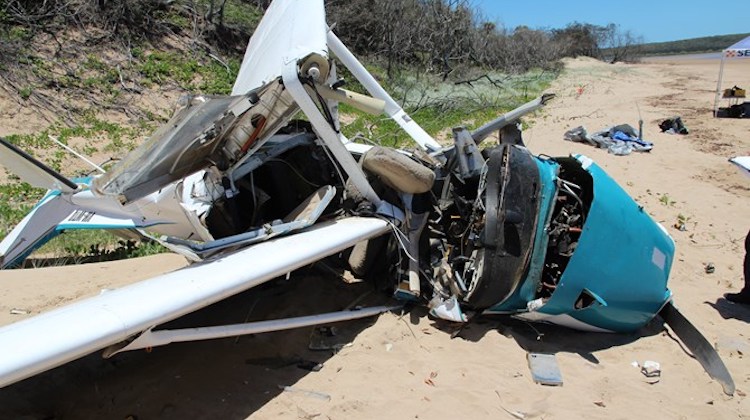
The Australian Transport Safety Bureau (ATSB) has called for upper torso restraints (UTR) to be fitted to all light aircraft in response to the crash of a Cessna C172M that left one passenger dead.
The incident occurred on January 10 2017, when the C172M VH-WTQ was operating a charter flight from Agnes Water aeroplane landing area (ALA) to Middle Island ALA on the Queensland coast when the engine had a “sudden and total power loss”.
“After conducting initial checks, the pilot elected to conduct a significant left turn to the beach,” the ATSB final report published on Thursday said.
“During the continued turn, the aircraft impacted the beach with little or no control and a significant descent rate.”
One person seated in the rear of the aircraft was killed, while the two other passengers and the pilot suffered serious injuries. The aircraft was destroyed.
The ATSB final report noted the aircraft’s rear seats were not equipped with upper torso restraints such as shoulder belts or harnesses.
“Such restraints were not required for seats (other than in the front row) of small aeroplanes manufactured prior to December 1986, however, numerous international investigation agencies (including the ATSB) and some aircraft manufacturers have recommended they be fitted,” the ATSB final report said.
“Had such restraints been fitted, the rear-seat passengers’ injuries would very likely have been less severe.”
The ATSB has issued a safety advisory notice to encourage owners and operators of small aircraft to fit upper torso restraints for all passenger seats to minimise injury risk.
ATSB chief commissioner Greg Hood said the safety recommendation was “particularly aimed at those aircraft being used for air transport operations, and where the aircraft manufacturer has issued a mandatory service bulletin to fit UTRs for all seats, or such restraints are readily available and relatively easy to install”.
“The ATSB strongly encourages operators and owners of small aeroplanes manufactured before December 1986 and helicopters manufactured before September 1992 to fit upper torso restraints to all seats in their aircraft, if they are not already fitted,” Hood said in a statement.
The ATSB final report said: “CASA has stated that it will not be mandating the fitment of upper torso restraints, even for air transport flights in small aircraft.”
“Given that a significant number of small aircraft in Australia still do not have upper torso restraints in non-front row seats, the ATSB has issued a safety recommendation to CASA.”
The ATSB final report said its investigation was unable to identify a reason for the loss of engine power.
However, the investigation did find the aircraft operator’s procedures and practices for conducting airborne inspections of the Middle Island ALA “did not effectively manage the risk of an engine failure or power loss when at a low height”.
The final report noted inspections were generally flown at 50–100 ft above mean sea level (AMSL) while flying at normal cruise speed towards an area of water at the end of the beach, “with no planned consideration of what to do in the event of an emergency”.
CASA called on the operator to cease flying after the accident. It then suspended the air operator’s certificate (AOC) on January 27 2017. The operators then asked CASA to cancel its AOC on March 10 2017.
The ATSB said its investigations found CASA’s “procedures and guidance for scoping a surveillance event included several important aspects, but it did not formally include the nature of the operator’s activities, the inherent threats or hazards associated with those activities, and the risk controls that were important for managing those threats or hazards”.
The full report can be read on the ATSB website.












